Got more than one fur baby in the household? A pet bunk bed is a great way of making them comfortable while saving space.
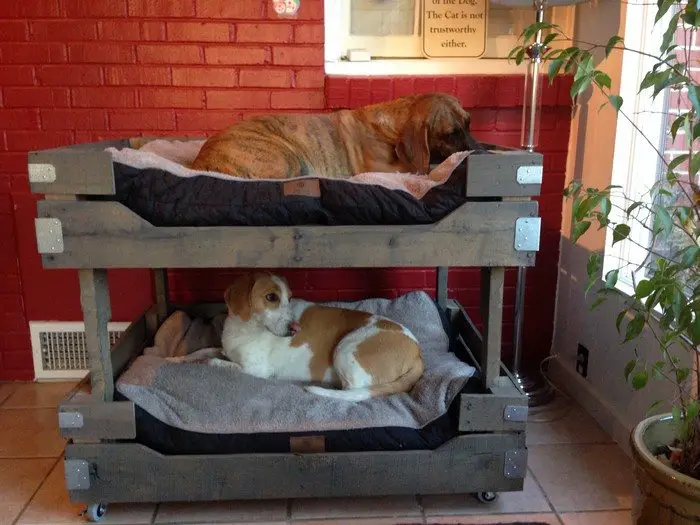
Some pets get along with each other really well, while some fight quite often like brothers and sisters. No matter how your fur babies treat each other, they always deserve to have their own, ‘personal space’.
A bunk bed doesn’t only allow your pets to enjoy some alone time. It also keeps the space occupied at a minimum since one bed is on top of the other. So if you’ve got two or more dogs but have a very limited space, a DIY dog bunk bed is the solution for you!
Building it yourself keeps your expenses low, too! You can use pallets, logs and other reclaimed timber. You can even repurpose and modify a crib or any old furniture you’re thinking of replacing!
Contents
- 1 Building a Pet Bunk Bed
- 2 Building a Bunk Bed for Different Types of Pets
- 3 Customizing Your Pet Bunk Bed
- 4 Choosing the Right Materials for Durability and Comfort
- 5 FAQ on Building a Pet Bunk Bed
- 5.1 What materials are best for a pet bunk bed?
- 5.2 How can I make my pet bunk bed safe for all my pets?
- 5.3 Can I customize my pet bunk bed to match my home decor?
- 5.4 How do I ensure the pet bunk bed is comfortable for my pet?
- 5.5 Are there eco-friendly options for building a pet bunk bed?
- 5.6 What should I do if my pet chews on the bunk bed?
- 5.7 How can I make the pet bunk bed easy to clean?
- 6 Conclusion
Building a Pet Bunk Bed
Materials
- Plywood
- Timber
- Nails
- Wood Glue
Tools
- Table Saw
- Jigsaw
- Measuring Tape
- Marker
- Hammer
- Nail Gun
- Drill
- Pocket Hole Jig
- Sander
- Wood Clamps
Instructions
Step 1: Plan Your Design
- Measure the space where you’ll place the bunk bed.
- Decide on the dimensions of the bed, keeping your pets’ sizes in mind.
- Sketch your design, including measurements for each piece of plywood and timber.
Step 2: Cut the Materials
- Use the table saw to cut the plywood for the bed platforms.
- Use the jigsaw to cut the timber into pieces for the frame, stairs, or ramps.
- Sand all edges to prevent splinters.
Step 3: Assemble the Frame
- Lay out the frame pieces according to your design.
- Apply wood glue to the ends of the timber pieces.
- Use the nail gun to secure the frame together.
- Clamp the frame with wood clamps until the glue dries.
Step 4: Attach the Bed Platforms
- Place the plywood pieces on each level of the frame.
- Secure the plywood to the frame with wood glue and nails.
- Ensure the platforms are stable and even.
Step 5: Build and Attach Stairs or Ramps
- Cut additional timber pieces for the stairs or ramp.
- Assemble the stairs or ramp using wood glue and nails.
- Attach the stairs or ramp to the bunk bed frame securely.
Step 6: Add Safety Railings (Optional)
- For pets that might fall off the top bunk, consider adding railings.
- Cut timber pieces for the railings.
- Attach the railings around the top platform with wood glue and nails.
Step 7: Sand and Finish
- Sand the entire bunk bed to ensure all surfaces are smooth.
- Wipe down the bed to remove dust.
- Apply a non-toxic finish or paint to protect the wood and add color.
Step 8: Add Bedding
- Place comfortable, washable bedding on each platform.
- Ensure the bedding fits snugly and is secure.
Building a Bunk Bed for Different Types of Pets
Building a bunk bed for your pets is a fantastic way to save space while providing a comfortable sleeping area. Whether you have dogs, cats, or even rabbits, a pet bunk bed can be a cozy and fun addition to your home. This guide will explore how to tailor a bunk bed to suit different types of pets.
Pet-Specific Design Considerations
When designing a bunk bed, consider your pet’s size, agility, and preferences. For dogs, sturdy materials and a comfortable stair are essential. Conversely, cats enjoy climbing and might appreciate a bunk bed with integrated scratching posts or perches. For smaller pets like rabbits, ensure the bed is low enough to the ground to prevent injuries from jumps.
Materials and Safety
Choosing the right materials is crucial for the durability and safety of the pet bunk bed. Use non-toxic paints and finishes, especially for pets that like to chew. Ensure all parts are securely fastened to prevent any accidents. Soft, washable bedding that fits each bunk snugly will make the bed more comfortable and easier to keep clean.
Accessibility
Not all pets are agile jumpers. Include ramps or steps for pets struggling to reach the top pet bunk bed. Consider a gentle slope instead of steep steps for older pets or those with mobility issues. This ensures all your pets can enjoy the bunk bed safely.
Customization for Comfort
Customize each bunk to suit its occupant’s preferences. Dogs might appreciate a cozy blanket or a pillow, while cats could enjoy a pet bunk bed with a built-in toy or a dangling string for play. For pets that value privacy, like rabbits, adding a soft curtain around the lower bunk can provide a sense of security.
Click on any image to start lightbox display. Use your Esc key to close the lightbox.![]()
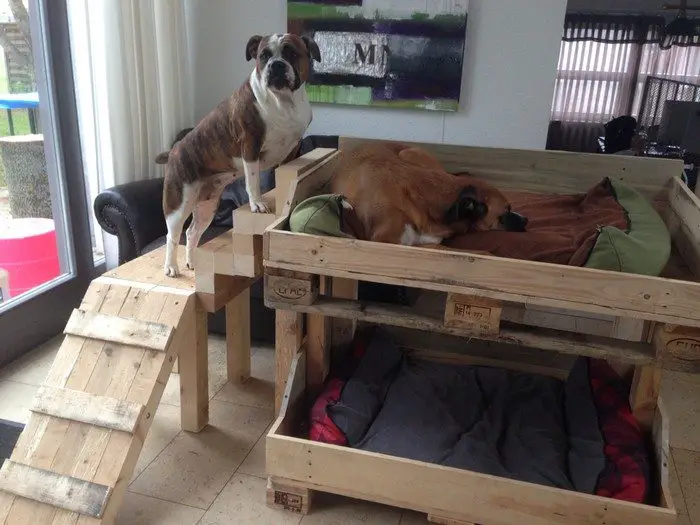
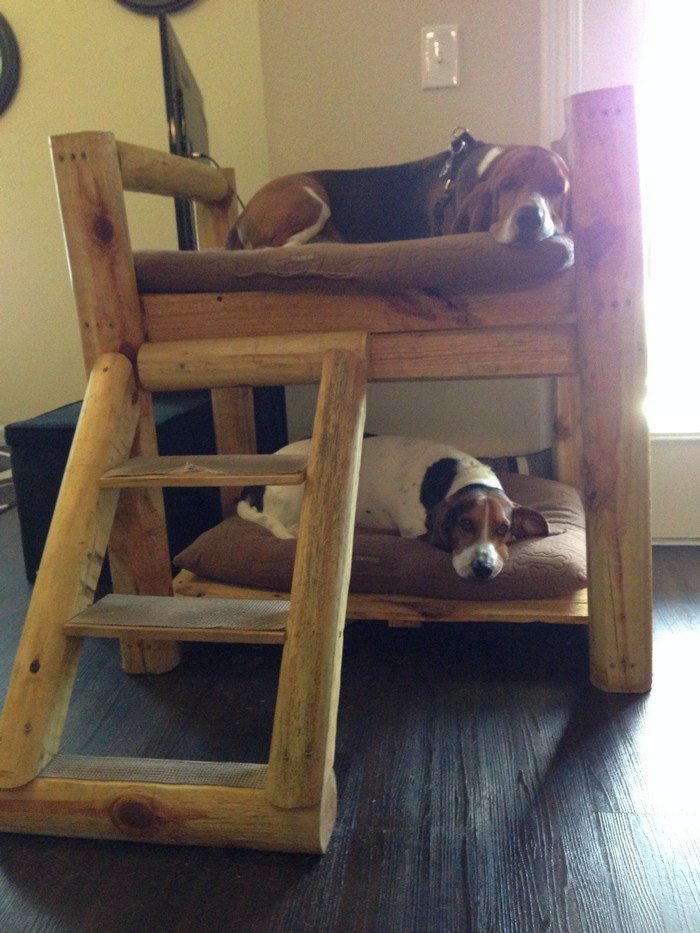

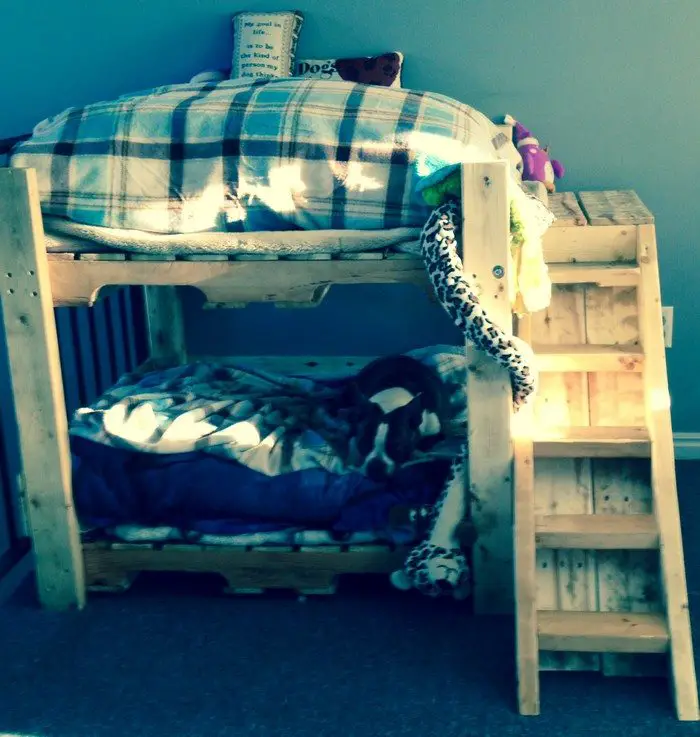
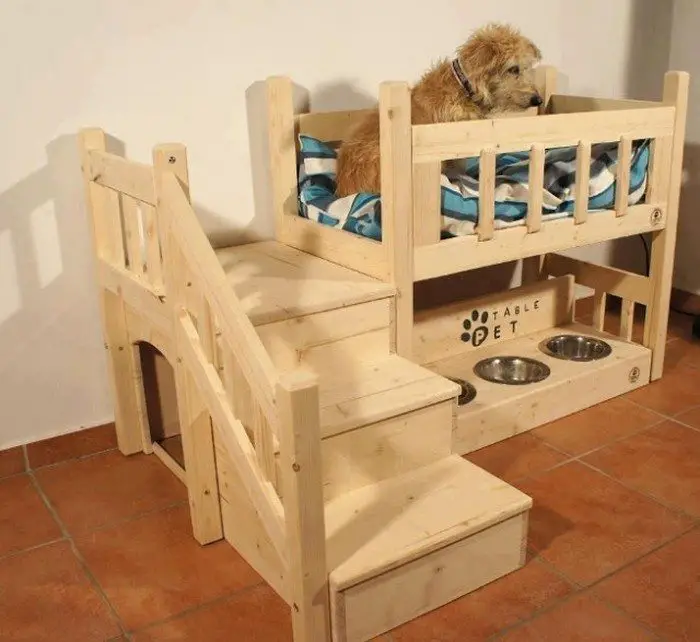

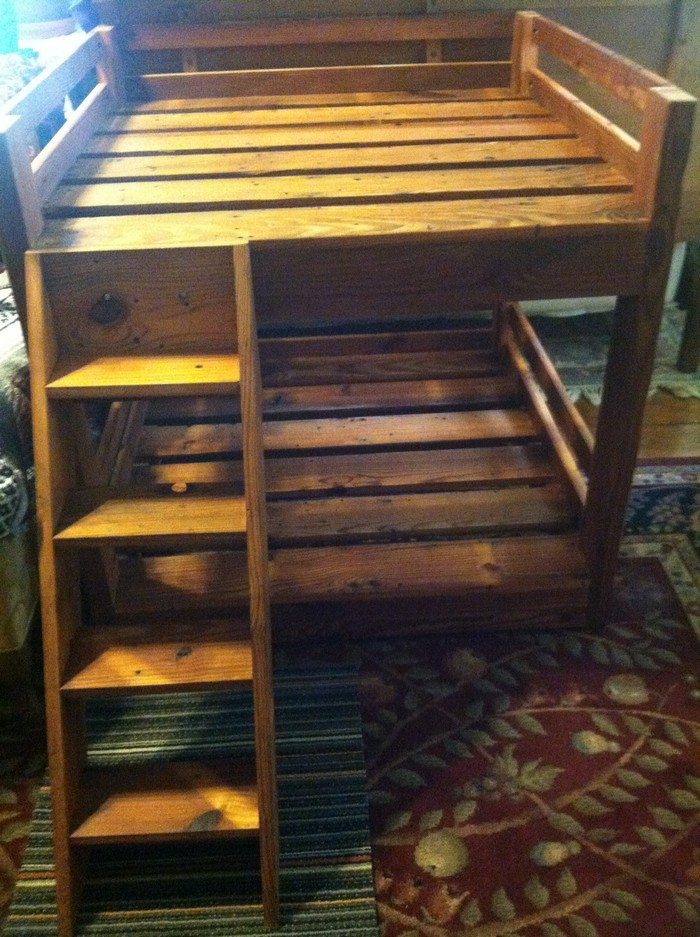
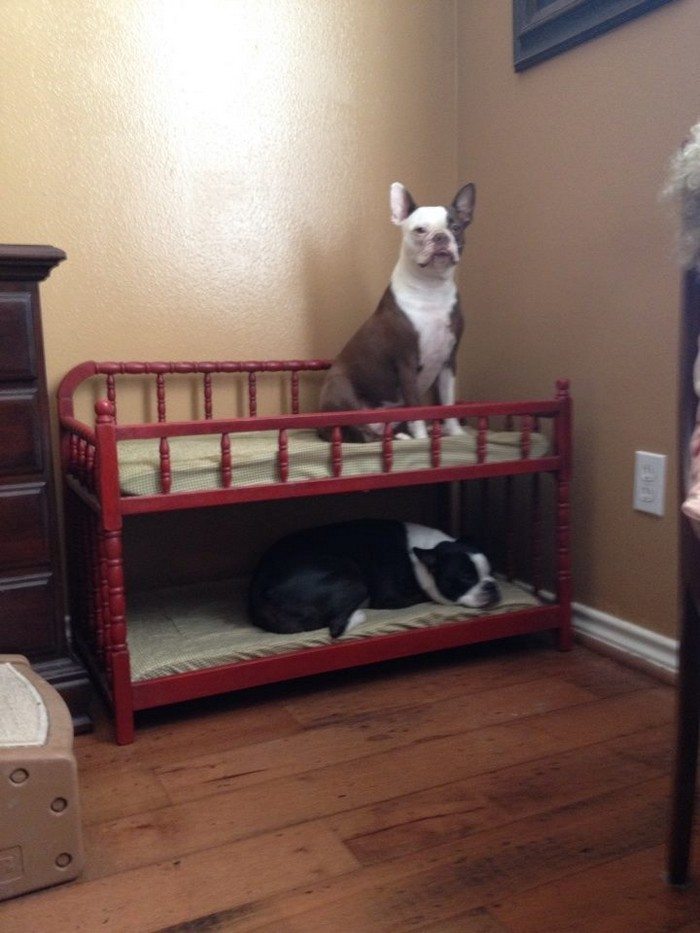

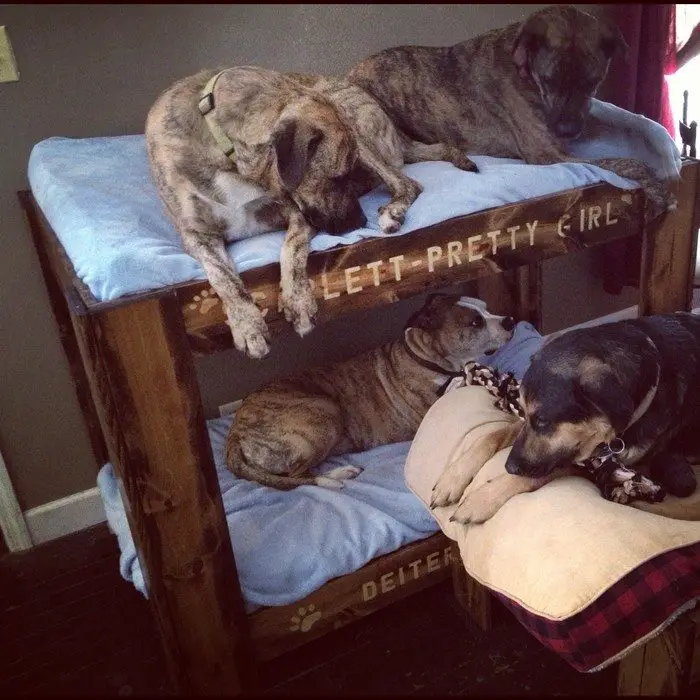
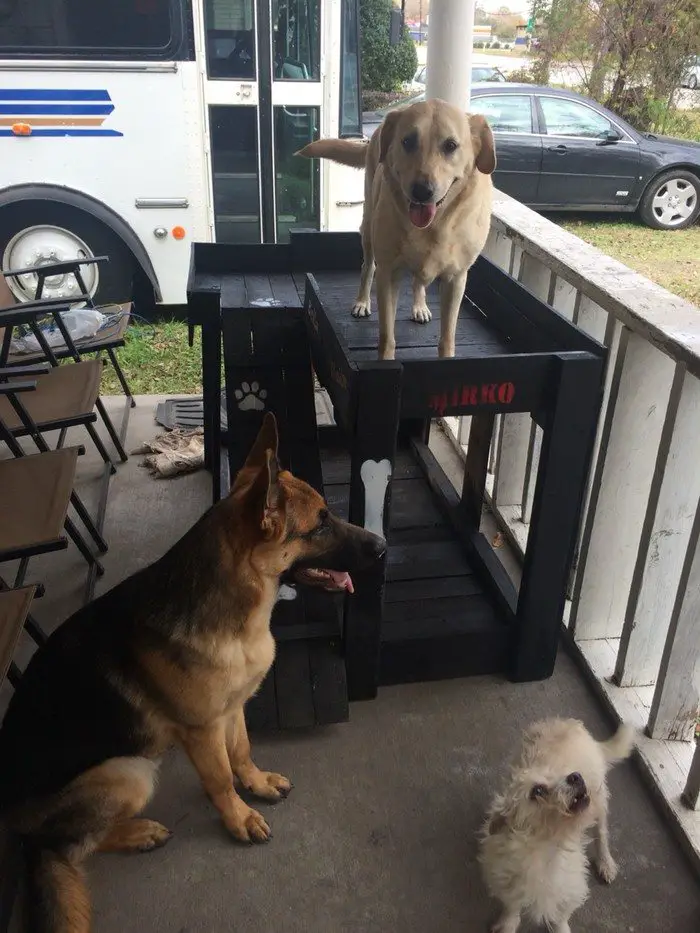

Customizing Your Pet Bunk Bed
Customizing your pet bunk bed not only adds a personal touch but also enhances your pet’s comfort and enjoyment. Whether for a cat, dog, or any other pet, a few custom features can make a big difference. Here’s how to personalize your pet bunk bed to suit your furry friend’s needs.
Choose a Theme
Selecting a theme for your pet bunk bed transforms it from a simple piece of furniture into a delightful centerpiece of your pet’s living space. Themes can range widely depending on your and your pet’s preferences.
For instance, a playful cartoon theme could be perfect for a cat’s pet bunk bed, turning each nap into an adventure. On the other hand, a dog’s pet bunk bed could embody a cozy cabin feel, making every sleep cozy and comforting. To bring your theme to life, paint the pet bunk bed with colors that resonate with the chosen theme.
If you’re artistically inclined, adding decals or stencils can introduce a layer of flair and personality. This makes the pet bunk bed more attractive and integrates it seamlessly into your home decor, making it a conversation piece for anyone who sees it.
Add Name Plates
Personalizing your pet bunk bed with nameplates is a wonderful way to cater to the individuality of your pets. This is more than just a decorative touch; it’s a way to make your pets feel truly at home. Using wooden plaques as the base, you can employ paint or a permanent marker to inscribe your pets’ names. These nameplates can then be securely attached to each bunk of the pet bunk bed, clearly marking who each space belongs to.
This is particularly useful in a household with multiple pets, ensuring that each pet knows its own designated resting area. Moreover, nameplates add a level of personalization that reflects the thought and care you’ve put into creating a comfortable and welcoming space for your pets. Whether your pets have distinct sleeping preferences or you simply want to celebrate their presence in your life, adding nameplates to the pet bunk bed achieves both functionality and heartfelt sentiment.
Incorporate Playful Elements
Enhancing your pet bunk bed with playful elements can significantly enrich your pet’s day-to-day life. For cat owners, integrating scratching posts on the sides of the pet bunk bed offers a perfect solution for their natural scratching instincts, keeping them engaged and sparing your furniture.
Additionally, consider suspending toys from the upper bunk of the pet bunk bed, which can stimulate your cat’s playful and predatory behaviors, providing hours of entertainment. Dog owners might find that incorporating a built-in toy box on the lower level of the pet bunk bed is an excellent way to keep toys organized and accessible, encouraging playtime and easy clean-up.
Attaching a cozy hideaway or an exploratory tunnel directly to the pet bunk bed for smaller pets, such as rabbits, can create a sense of security and adventure within their own private space. These modifications make the pet bunk bed a restful place and a hub of activity and joy for your pets.
Optimize for Comfort
The comfort of your pet bunk bed is paramount for ensuring your pets enjoy their rest time to the fullest. To achieve this, each bunk of the pet bunk bed must be equipped with a mattress or cushion that fits the space perfectly, offering a soft and supportive resting area for your pets. Choosing washable covers for these mattresses or cushions is a practical way to maintain hygiene and freshness, as they can easily be removed and cleaned.
Moreover, incorporating removable covers in various colors or patterns can instantly refresh the appearance of the pet bunk bed and allow you to customize the look to match your home decor or to celebrate different seasons and holidays. This approach to optimizing comfort in your pet bunk bed ensures a cozy sleeping environment for your pets and adds a touch of style and personalization to their space.
Safety Modifications
Ensuring the safety of your pet bunk bed is critical, especially for pets that may find climbing challenging or are at risk of falling. Incorporating safety features can significantly reduce these risks and provide peace of mind.
Adding side railings to the top bunk of the pet bunk bed can prevent falls, offering a secure barrier that allows your pets to rest without the danger of slipping off. For pets that struggle with stairs, installing a small ramp can provide an alternative means of easily accessing the upper bunk.
The railings are particularly beneficial for older pets or those with mobility issues, ensuring they can safely enjoy the elevated space of the pet bunk bed. These practical safety modifications demonstrate thoughtful consideration of your pet’s needs and limitations, ensuring the pet bunk bed is a safe and welcoming space for all.
Use Durable Materials
Selecting the right materials for your pet bunk bed is essential for its longevity and the safety of your pets. Durable materials that can withstand the inevitable wear and tear are crucial, especially in a home with active or multiple pets. When customizing your pet bunk bed, opting for robust materials that resist damage from scratching, chewing, and general use ensures the bed remains in good condition over time.
Additionally, if your pets are inclined to chew, choosing non-toxic, pet-safe materials is vital to prevent health risks. Materials such as solid wood, metal, or high-density plastics can offer durability and safety while also being easy to clean and maintain. By selecting the right materials for your pet bunk bed, you ensure a lasting, safe, and enjoyable resting place for your pets, safeguarding their health and comfort in the long run.
Choosing the Right Materials for Durability and Comfort
When building a pet bunk bed, selecting the right materials is crucial for ensuring both durability and comfort. The materials you choose will affect how well the bed stands up to wear and tear, as well as how comfortable it is for your furry friends. Here’s how to pick the best materials for your pet bunk bed project.
Durability Factor
For the structure of the pet bunk bed, you need materials that can withstand the rigors of pet use. Hardwoods like oak or maple are excellent for their strength and resistance to scratching and denting. Alternatively, high-grade plywood can offer durability at a more affordable price point. These materials ensure the pet bunk bed remains sturdy and secure, even with active pets.
Safety Comes First
Safety is paramount regarding paints, finishes, and any additional materials that your pets might chew or lick. Look for non-toxic, pet-safe options that won’t harm your pets if ingested. This is especially important for pets that chew on wood or other materials. Water-based paints and finishes are often a safer choice, as they contain fewer volatile organic compounds (VOCs).
Comfort for Your Pets
The choice of bedding material is also crucial for your pet bunk bed. Opt for soft, yet durable fabrics that can easily be washed. Memory foam or orthopedic mattresses offer great support and comfort, especially for older pets or those with joint issues. Removable covers made from cotton or microfiber provide a soft surface that’s easy to keep clean and free from pet hair and odors.
Weather and Wear Resistance
If the pet bunk bed will be placed in an area exposed to elements or high moisture, such as a covered patio, consider weather-resistant materials. Cedar and teak are naturally resistant to decay and pests, making them ideal for outdoor use. For fabrics, choose water-resistant and UV-protected to prevent fading and mildew growth.
Consider the Pet’s Habits
Knowing your pet’s habits can guide your material choices. For pets that tend to chew, opt for materials that are more durable and chew-resistant, such as hardwoods or heavy-duty fabrics. For pets that scratch, consider scratch-resistant surfaces or add protective covers to vulnerable areas.
Easy Maintenance
Choose materials that are easy to clean and maintain. Removable cushion covers, waterproof liners, and materials that resist staining can save you time and effort in upkeep. Materials like synthetic fabrics or sealed wood can be wiped down easily and are less likely to harbor odors or bacteria.
Eco-Friendly Options
For pet owners concerned about the environment, there are eco-friendly material options. Recycled plastics, sustainable woods, and organic fabrics are all responsible choices that do not compromise on durability or comfort. These materials are often just as robust and comfortable as their traditional counterparts but have a lower environmental impact.
Allergy Considerations
If your pets or any family members have allergies, consider hypoallergenic materials for the pet bunk bed. Materials that do not easily collect dust, dander, or other allergens can help maintain a healthier environment. Look for hypoallergenic fabrics for bedding and cushions, and prefer solid woods over particle boards, which may contain irritants.
Temperature Regulation
Materials that help regulate temperature can provide additional comfort for your pets. For warmer climates, breathable fabrics and lighter woods can help keep pets cool. In cooler environments, materials with insulating properties, like denser woods or plush fabrics, can keep pets warm and cozy.
Aesthetic Appeal
While functionality is crucial, the appearance of the pet bunk bed also matters. Choose materials that complement your home’s decor. Natural woods, stylish fabrics, and tasteful finishes can make the pet bunk bed a beautiful addition to any room, ensuring it fits seamlessly with your existing furnishings.
FAQ on Building a Pet Bunk Bed
What materials are best for a pet bunk bed?
Hardwoods like oak or maple are great for durability, while high-grade plywood can be a cost-effective alternative. For safety, use non-toxic, pet-safe paints and finishes. For bedding, choose washable fabrics that provide comfort and support, like memory foam with removable cotton or microfiber covers.
How can I make my pet bunk bed safe for all my pets?
Add safety features like side railings on the top bunk to prevent falls. For pets with mobility issues, consider a ramp instead of stairs for easier access. Ensure all materials used are non-toxic and chew-resistant if necessary.
Can I customize my pet bunk bed to match my home decor?
Absolutely! Paint the bunk bed in colors that complement your home decor and add personal touches like name plates or themed decorations. Choose bedding in colors or patterns that match your style.
How do I ensure the pet bunk bed is comfortable for my pet?
Opt for a soft mattress or cushion that fits the bunk size perfectly. Consider orthopedic mattresses for older pets or those with joint issues. Use washable and removable covers to keep the bed clean and cozy.
Are there eco-friendly options for building a pet bunk bed?
You can choose sustainable materials such as recycled plastics, bamboo, or reclaimed wood. Look for organic or eco-friendly fabrics for bedding to further reduce your environmental impact.
What should I do if my pet chews on the bunk bed?
Choose durable, chew-resistant materials like hardwood or metal for the frame. You can also apply a non-toxic bitterant on the bed’s surfaces to deter chewing.
How can I make the pet bunk bed easy to clean?
Select materials that are stain-resistant and easy to wipe down. Use removable and washable bedding covers, and consider waterproof liners to protect mattresses from accidents.
Conclusion
A pet bunk bed offers a unique opportunity to provide your furry friends with a comfortable, safe, and personalized sleeping space. By carefully selecting durable materials, incorporating safety features, and adding personal touches, you can create a bunk bed that saves space and enhances your pets’ overall well-being.
For more projects that will make your pets comfortable, read our closet dog bedroom project next!






